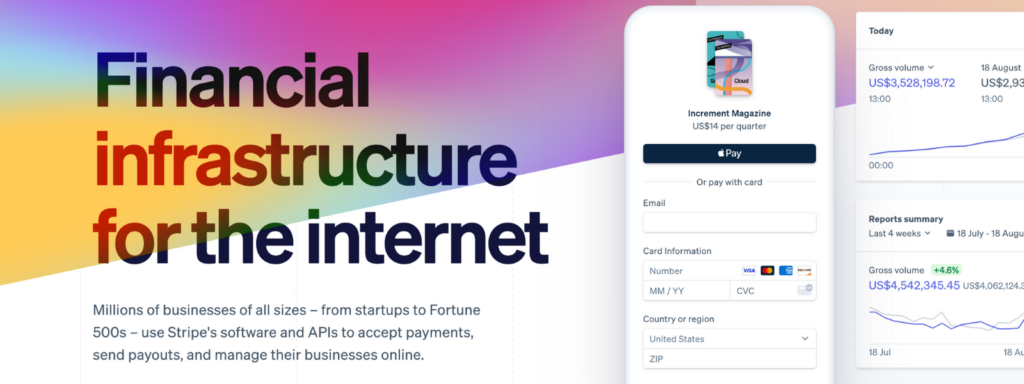Stripe for Freelancers: Is it a Good Payment Solution?

Finding a reliable and efficient payment solution is a crucial aspect of ensuring smooth business operations. For many freelancers, the traditional methods of payment can be cumbersome and time-consuming, leading to delays and potential cash flow issues. However, with the emergence of online payment platforms such as Stripe, the freelancing community has gained access to a promising solution that allows users to streamline transactions and simplify the payment process.
In this article, we will take a look at the popular payment platform Stripe for freelancers, and explore its features, benefits, potential drawbacks, and overall suitability for freelancers operating in diverse industries.
Table of Contents [Show]
What is Stripe?

Stripe is a full-integrated payment service provider (PSP) that has become popular in recent years. With Stripe, businesses can accept payments from debit and credit cards, digital wallets, ACH payments, and over a dozen other alternative payment methods in over 135 currencies. Stripe offers a simple and effective way for freelancers and other business owners to collect client payments, whether internationally or locally.
This payment solution offers ways to invoice clients and collect payments directly on the platform, and works best for eCommerce businesses and freelancers looking to streamline the payment process. Stripe is a highly secure payment service provider and takes extra precautions to protect their clients’ data and finances. Many large brands are known to use Stripe for their payment processes, including Amazon, InstaCart, Shopify, Salesforce, and even Google.
Benefits of Using Stripe for Freelancers

Seamless Payment Processing
First and foremost, Stripe offers seamless and efficient payment processing services. By using Stripe’s integrated billing, tax, revenue reporting, and data tools, users can streamline their business processes and spend their time dealing with clients or projects. Currently, over 250,000 businesses use Stripe’s finance automation platform to operate with efficiency, simplify their tax compliance, and close their books.
Global Accessibility
Stripe is currently available to use in over 20 different countries, including the US, Canada, Australia, France, Japan, and more. Users can send and receive international payments and automatically convert currencies within the platform, making it easier to receive remuneration from clients living abroad.
Transparent Pricing and Fees
There are no hidden fees when using Stripe for freelancers; only a standard 2.9% transaction charge is applied to each payment, plus a $0.30 fee per transaction. There are no monthly fees or additional charges to use certain features, and setting up an account on Stripe is free of charge.
Seamless Third-Party Integrations
Freelancers can benefit from Stripe’s various third-party integrations and APIs. Users can connect other applications, such as Salesforce, PrestaShop, and PayPal, to further streamline business processes and automate their workflows.
Stripe Radar
According to PwC, fraud costs businesses worldwide an estimated $42 billion every year. Stripe Radar is the platform’s very own machine-learning tool, aimed at preventing financial fraud by identifying suspicious behavior and warning users. Radar also automatically applies Dynamic 3D Secure to what it deems as a high-risk payment. Radar’s algorithm quickly adapts to shifting fraud patterns, as well as your own business patterns, for comprehensive fraud protection.

Invoicing Features
Not only can freelancers request and receive payments through Stripe, but they can also invoice their clients directly from the platform. Users can create invoices, complete with taxes and discounts, within mere minutes, and can choose to send recurring invoices to regular clients. Freelancers can also utilize Stripe’s email reminders and aging reports to collect their unpaid invoices.
Considerations and Limitations of Using Stripe for Freelancers
While Stripe has a plethora of benefits for freelancers, there are also some limitations to consider when deciding on a suitable payment platform.
Longer Waiting Times
Stripe may not be the best payment processor for freelancers looking for timely payments. While many other platforms take around 2-5 business days to process transfers, and some only hours or minutes, Stripe can take up to 10 working days, which is not ideal for optimized cash flow.
Limited Availability
As mentioned previously, Stripe is currently only available in around 20 countries, many of them first-world. This makes it difficult to collect payments from clients in unsupported countries and is not a viable option for any freelancers living outside Stripe’s list of supported locations.
Expensive
Stripe’s consistent 2.9% transfer fee can seem fair when working with smaller payments, but fees for larger payments can become costly to freelance business owners. Additionally, these charges build up in the long term, which some freelancers may be unable to afford.
Conclusion
Stripe offers a compelling payment processor for freelancers, providing seamless payment processing, global accessibility, transparent pricing, and robust fraud protection through Stripe Radar. Its user-friendly interface and integration capabilities make it an attractive choice for freelancers looking to streamline their payment processes and improve overall efficiency.
However, freelancers should carefully consider the longer waiting times for transfers, limited availability in certain countries, and potential expense for larger payments when deciding if Stripe is the right fit for their needs. Evaluating these factors alongside the platform’s numerous benefits will help freelancers make an informed decision about whether Stripe is a good payment solution for their freelance business.

